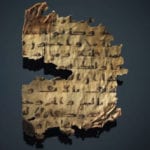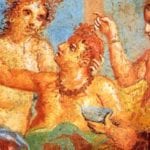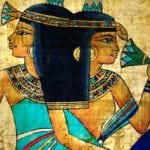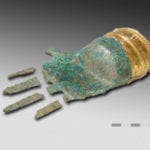 Movies and TV
Movies and TV  Movies and TV
Movies and TV  Humans
Humans 10 Times Scientists Were Absolutely Sure… and Absolutely Wrong
 Our World
Our World 10 Pivotal Moments for Life on Earth
 Movies and TV
Movies and TV 10 Most Realistic Medical TV Shows of All Time
 Creepy
Creepy 10 Eerie & Mysterious Ghosts of the Pacific Coast
 Weird Stuff
Weird Stuff 10 Typos That Accidentally Changed History
 History
History 10 Times Trickery Won Battles
 Technology
Technology 10 Awesome Upgrades to Common Household Items
 Misconceptions
Misconceptions 10 Hilarious (and Totally Wrong) Misconceptions About Childbirth
 Weird Stuff
Weird Stuff 10 Warning Labels That Exist Because Someone Actually Tried It
 Movies and TV
Movies and TV 10 Zombie Movies That Will Actually Terrify You
 Humans
Humans 10 Times Scientists Were Absolutely Sure… and Absolutely Wrong
 Our World
Our World 10 Pivotal Moments for Life on Earth
Who's Behind Listverse?

Jamie Frater
Head Editor
Jamie founded Listverse due to an insatiable desire to share fascinating, obscure, and bizarre facts. He has been a guest speaker on numerous national radio and television stations and is a five time published author.
More About Us Movies and TV
Movies and TV 10 Most Realistic Medical TV Shows of All Time
 Creepy
Creepy 10 Eerie & Mysterious Ghosts of the Pacific Coast
 Weird Stuff
Weird Stuff 10 Typos That Accidentally Changed History
 History
History 10 Times Trickery Won Battles
 Technology
Technology 10 Awesome Upgrades to Common Household Items
 Misconceptions
Misconceptions 10 Hilarious (and Totally Wrong) Misconceptions About Childbirth
 Weird Stuff
Weird Stuff 10 Warning Labels That Exist Because Someone Actually Tried It
10 Intriguing Mysteries Of Atenism In Ancient Egypt
Through most of the known history of ancient Egypt, the population worshiped multiple gods, with private citizens free to worship whatever gods they saw fit within the privacy of their own home. Nevertheless, the comparatively brief period during which the country suddenly turned to monotheism in the form of Atenism is perhaps one of the most intriguing, and mysterious.
Just where did this strange and apparently alien religion come from? Why did it take hold with so little resistance? Why did it vanish so suddenly afterward? And why is it that arguably the most well-known pharaoh of ancient Egypt in our contemporary times, Tutankhamun, is seemingly at the middle of this strange time in one of the most glorious and far-reaching civilizations in all of known history? Here are ten intriguing facts about Aten, Atenism, and why its place in history is quite possibly very important.
10 It (Seemingly) Came Out Of Nowhere

Although we will come back to an intriguing aspect of just where such focus on Aten and Atenism came from later, it would appear that after over almost 2,000 years of steady, entrenched polytheism, such practices were simply wiped away when, in the fifth year of his reign, Pharaoh Amenhotep IV changed his name to Akhenaten and introduced Atenism.[1]
In his ninth year, instead of worshiping multiple gods, Akhenaten proclaimed Aten the one and only god. Furthermore, no image was to be made of this god, as it didn’t manifest and could not be “seen.” The only representation of Aten was the flat solar disk—essentially, the Sun.
What is even more interesting is the fact that despite some sparing mentions of Aten in old (even to the ancient Egyptians) writings confirm that it was a solar deity, it was not, as the ancient Egyptians would have understood it, a god. As we will examine later, the origins of this ideology were seemingly always underlying ancient Egyptian culture, although it very likely was only found in certain mystery schools of Heliopolis, whose far-reaching connections are as intriguing as they are entangling.
9 There Was No Apparent Resistance To The Change
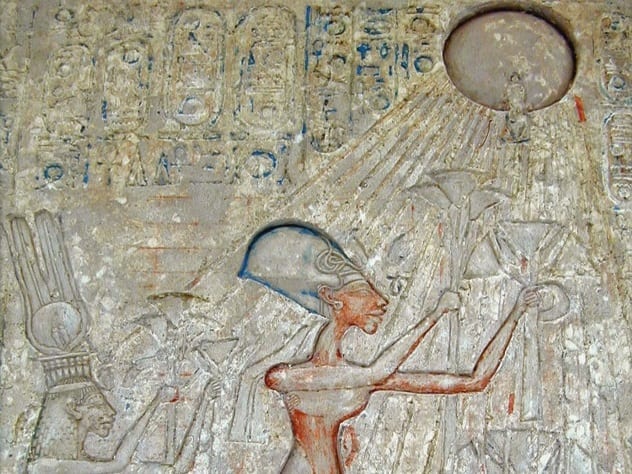
Furthermore, as opposed to an expected resistance, such as an attempt to overthrow the pharaoh and his new religion, it would appear, at least from the historical records that remain of the period, that the entire population simply accepted the sweeping changes.[2]
Despite ancient Egypt having a strong and well-trained army, there were seemingly no attempts whatsoever to overthrow Akhenaten. This was despite Akhenaten moving to a new capital, from Thebes to what is now called Amarna.
What maybe makes this even stranger is that Atenism disappeared so quickly after a period of around two decades. And, equally as suddenly, it was one of the successors to Akhenaten, perhaps one of the most famous pharaohs, who would restore the old ways of Amun-Ra. We will examine that particular pharaoh shortly.
8 The Similarities To Early Abrahamic Religions, Secret Societies, And The Freemasons

While this point could take up entire volumes in its own right, many of the apparent practices of Atenism, particularly as seemingly taught in the mystery schools at Heliopolis, seem to have been a precursor to the three main Abrahamic religions that would follow after, particularly very early Judaism and, in turn, Christianity.[3]
These claims are perhaps even more convincing when we factor in the mysterious figure of Aper-El (also spelled Aperel), who served as Akhenaten’s chief minister and was, according to discoveries made in his tomb, very likely of early Hebrew/Israelite origin. In fact, the connections to early religions and more specific writings of the Old Testament are as intriguing as they are many.
In a similar vein, especially when we take the studies and investigations of numerous authors into account, much can be said for various secret societies and their customs and origins, perhaps not least the Knights Templar and, in turn, Freemasonry. And even within the teachings of Christianity and the Roman Church throughout Europe, during the thousands of years that followed the events we are discussing here, these secret teachings and discreet connections have continued.
7 The Attempts To Erase Atenism From Ancient Egyptian History
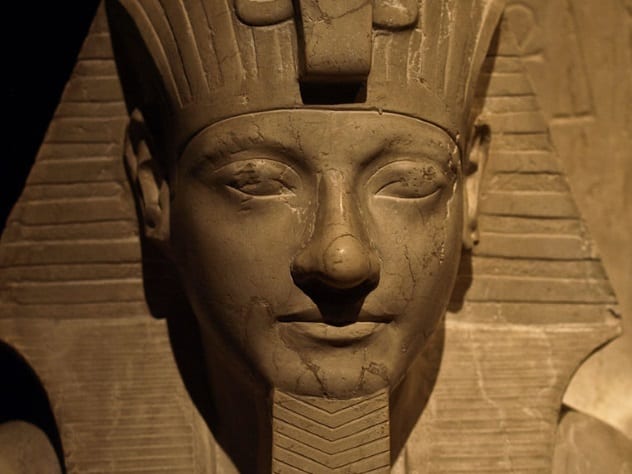
Following its disappearance from the collective psyche of ancient Egypt, there came an apparent attempt to erase all records of Atenism from history. Indeed, much of what we know of the period is from what little remains of it in Egyptian records (essentially what was overlooked or too inaccessible to destroy) or from surrounding civilizations’ records.
As mentioned in the introduction, perhaps the most famous, well-known, and easily recognizable of the ancient Egyptian pharaohs is a mystery himself. Of all the pharaohs during this period, despite being erased from history, his mummy was well-preserved and guarded as opposed to the desecration that was dished out upon the others.
Indeed, it appears that the pharaohs who followed went to great lengths to not only distance themselves from Atenism but, beginning with Horemheb, actively pursued anyone practicing or preaching such ideology, destroyed monuments, and erased inscriptions.[4]
There has been much speculation as to the reason for this apparently delayed reaction, and it ranges from mundane claims of simple revolution to crazily outlandish assertions of extraterrestrial intervention. As we move into the second half of our list, we’ll see that the answer could have been somewhere in the middle, between those two extremes.
6 The Tutankhamun Connection
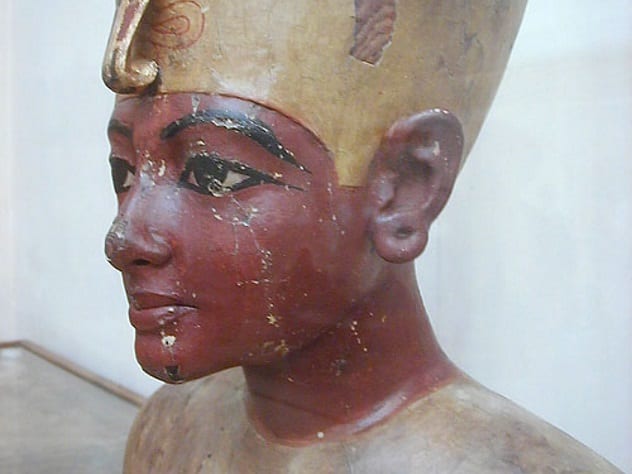
Before we get into the potential reasons for this intriguing but bizarre period in ancient Egyptian history, we should perhaps turn our attention back to the famous pharaoh whose reign came during the era but was nevertheless responsible for returning the religious focus back to the way it was before Akhenaten: Tutankhamun.[5] He is arguably the most well-known of the ancient Egyptian pharaohs, certainly to us in the modern age.
Indeed, he would change his name from Tutankhaten to Tutankhamun as a public display of his casting off Atenism. Even so, his name was still removed from official royal records along with the other rulers during this time. Of even further interest is the tomb which sits directly across from that Tutankhamun, only meters away: Tomb 55, also known as KV55.
5 The Mysterious Tomb 55

Quite possibly the most intriguing and mysterious aspect of Atenism is the discovery of the contents of what became known as Tomb 55.[6] What is particularly strange about it is that it reportedly originally bore the seal of Tutankhamun. (This claim remains unverified.) Tut, of course, was buried nearby, and his tomb wasn’t discovered until a number of years later.
What is even more interesting about Tomb 55 is the notion that it was actually sealed to keep the mummy inside as opposed to keeping rogue thieves and robbers out. Given what we know of the beliefs of the time in curses and the vengeance of the gods, this is an interesting, if ominous detail. Furthermore, the body of the mummy had been purposely desecrated as well as appearing and being displayed as female, despite the fact it was discovered to be male.
4 Statues Of Sekhmet Suddenly Appear Everywhere
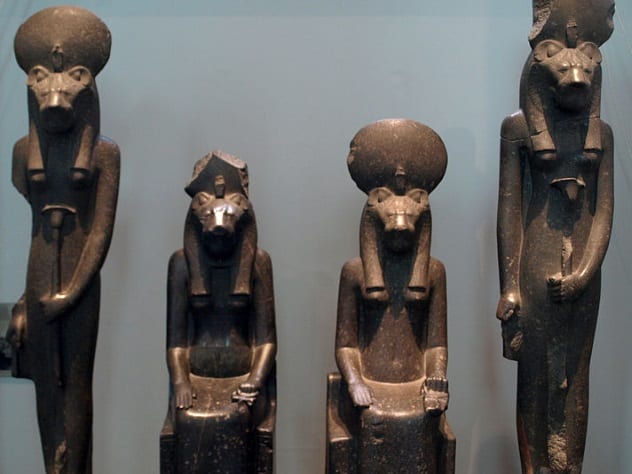
During his reign, Amonhotep III erected 600 statues of Sekhmet at the Temple of Mut.[7] He around 730 statues constructed in total. Why was this?
What is perhaps interesting here is that this particular deity was associated with, among other things, disaster. This, according to some researchers, suggests that something very grave was taking place in ancient Egypt.
Incidentally, according to ancient Egyptian mythology, Sekhmet, the daughter of Ra, had attempted to destroy the world and had to be kept at bay by Ra. This might be very important. Our final points, which we collectively owe to the research and investigative skills of author Graham Phillips, may just provide the missing answers to what is surely the most mysterious period in “known” ancient Egyptian history.
3 A Coincidental Cataclysmic Disaster?

In his book Act Of God, author, researcher, and investigator Graham Phillips argues that the reason for these statues, and indeed the apparent submission of the entire nation in the face of this drastic change, was down to a cataclysmic disaster striking the nation, specifically a huge, and deadly, volcanic eruption from Mount Thera (aka Santorini), the effects of which would have been more than felt in the lands of Egypt.[8]
Might this have been the reason for accepting such drastic change? Might the skies have darkened as a result of a massive volcanic explosion? Might this prove to be the reason why Akhenaten made the decision to worship Aten—the sun disc?
What is also interesting here is that many of the apparent plagues which hit ancient Egypt, at least according to legends and Biblical writings, could be satisfactorily explained as a consequence of such a natural disaster, including, but certainly not limited to, the darkening of the skies (or the Sun). As these plagues continued, and with the nation coming to the realization that worshiping Aten was not stopping such disasters, a quick conversion back to the old gods was seen as the only way to end the horror.
In short, and given what we know of ancient Egyptian ideology, culture, and thought, there was an unintentional manipulation of a naturally occurring but cataclysmic event that not only ushered in Atenism but then ushered it out again. Our last points, though, are perhaps most spine-tingling of all.
2 The Hyksos And The Exodus
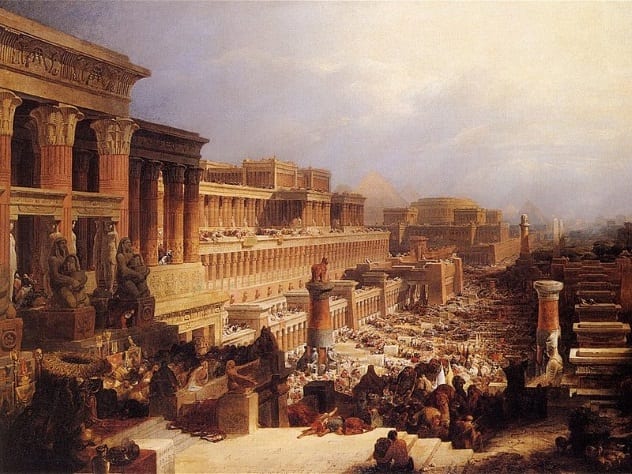
As an intriguing aside to the equally intriguing affair is the presence of a mysterious group of people in the region, the Hyksos. This mysterious group, according to some researchers, were the early Hebrews of the Old Testament and, in turn, part of the apparent bloodline of Jesus. Indeed, some researchers even claim that Jesus may well have been, by family ties and bloodlines, a pharaoh in exile in Jerusalem by the time of His birth, whose wealthy family were very likely from the Heliopolis region. When coming of age, He was likely taught the same teachings as were taught in the mystery schools of the regions thousands of years before His own existence.
Coming back to ancient Egypt, however, it would appear that the Hyksos were also part of the Exodus, which, while historically believed to be a myth, could well have taken place off the back of the outlawing of Atenism. Much of the Old Testament has obvious connections to ancient Egyptian writings. And while history, the Bible, and even the movies claim that the Exodus led by Moses took place during the reign of Ramses II, there is evidence to suggest, much of which we have examined above, that it, in fact, took place a century previously, during the reign of Akhenaten.[9]
To understand this, we return once again to Graham Phillips.
1 Was Thutmose The Real Moses?
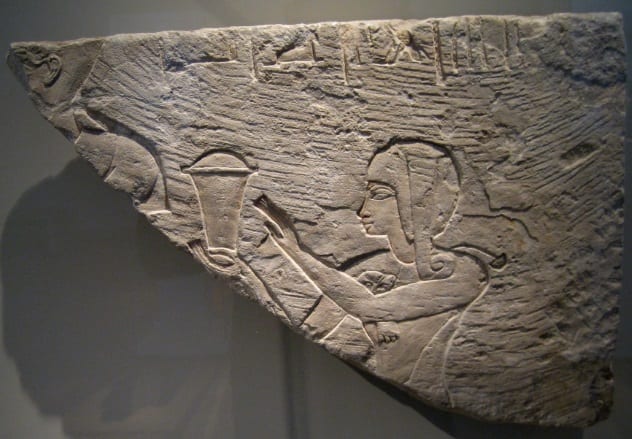
Indeed, Phillips notes that Crown Prince Thutmose should, by rights, have been the next in line for the throne following Amenhotep III.[10] However, instead, Akhenaten takes charge, and Thutmose seemingly disappears from the picture. (Most historians assume he died.) When we know that an inscription on a wine jar for Akhenaten describes him as the “the true King’s son,” this now begins to sound like the Moses and Ramses II story. Now note that the word “son” in ancient Egyptian is mose. The Greek version of this word, incidentally, is mosis.
If we also believe, then, that Thutmose had to go into exile due to Akhenaten perhaps conspiring to kill him for his rightful place on the throne as the “king’s true son,” and if we also accept that Thutmose had abandoned the “Thut” (“god”) part of his name, then the connections between Mose and Moses are strong.
Might it be, as speculative as this all is, that the three main Abrahamic religions of our contemporary age are directly connected to the religious ideology from the mystery schools of ancient Egypt, preserving, in a bizarre way, the thought process and spirituality of one of the greatest civilizations to ever grace the Earth?
Read more odd facts about ancient Egypt on 10 Unsolved Mysteries Of Ancient Egypt and 10 Bizarre Facts About The Pharaohs Of Ancient Egypt.
